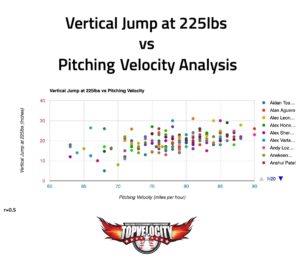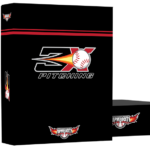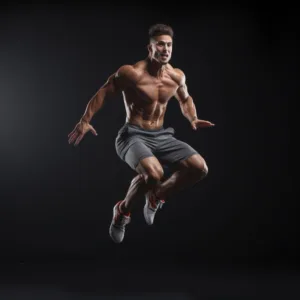 Predicted Pitching velocity is a critical performance metric for baseball pitchers, serving as a key indicator of their effectiveness on the mound. A higher pitching velocity can enhance a pitcher's ability to challenge hitters and improve their overall performance. Consequently, understanding the factors that contribute to pitching velocity is essential for coaches and scouts aiming to identify and develop talent more effectively. Traditional approaches have often focused on advanced kinetic parameters and biomechanics, which, while valuable, may not always be practical for quick assessments in tryout settings. This necessitates the exploration of more accessible methods that can reliably predict pitching performance.
Predicted Pitching velocity is a critical performance metric for baseball pitchers, serving as a key indicator of their effectiveness on the mound. A higher pitching velocity can enhance a pitcher's ability to challenge hitters and improve their overall performance. Consequently, understanding the factors that contribute to pitching velocity is essential for coaches and scouts aiming to identify and develop talent more effectively. Traditional approaches have often focused on advanced kinetic parameters and biomechanics, which, while valuable, may not always be practical for quick assessments in tryout settings. This necessitates the exploration of more accessible methods that can reliably predict pitching performance.
This study addresses this need by investigating the correlation between pitching velocity and various anthropometric measurements and physical tests. These tests are designed to be easily implemented in tryout settings, making them practical for rapid and cost-effective assessments. By identifying which physical attributes and performance metrics are most closely linked to pitching velocity, the study aims to provide a useful tool for coaches and scouts. This can help in making informed decisions about player potential, thereby enhancing the talent identification process in baseball.
Background: Predicted Pitching Velocity
Research on pitching velocity has evolved significantly over the years. Traditionally, studies have focused on kinetic parameters, such as elbow and shoulder movements, to understand pitching performance. More recently, attention has shifted to anthropometric measurements and strength and conditioning as key predictors of pitching velocity.
Factors Influencing Pitching Velocity
- Kinetic Parameters: These include the movement patterns and forces generated by the pitcher's elbow and shoulder.
- Anthropometric Measurements: Factors like height, weight, and age can influence a pitcher's ability to generate velocity.
- Strength and Conditioning: Physical strength and conditioning play a crucial role in a pitcher's performance.
Study Objective: Predicted Pitching Velocity
The primary aim of this study was to develop a predictive model for pitching velocity based on easily obtainable anthropometric measurements and physical test results. We hypothesized that a combination of these factors could accurately predict pitching velocity in tryout settings.
Methodology: Predicted Pitching Velocity
The study involved 64 Asian adult male pitchers who participated in a tryout event for a professional baseball team in Taiwan in 2019. Participants underwent various anthropometric measurements and physical tests designed to assess their potential pitching velocity.
Participant Selection
 Participants were selected based on their performance in initial tryout rounds. Those with a pitching velocity of less than 130 km/h were excluded from the study.
Participants were selected based on their performance in initial tryout rounds. Those with a pitching velocity of less than 130 km/h were excluded from the study.
Testing Protocols
- Warm-up: Participants completed a standardized 10-minute dynamic warm-up.
- Anthropometric Measurements: Height, weight, and age were recorded.
- Physical Tests: These included measurements of maximum external and internal shoulder rotation, countermovement jump height, loaded CMJ height, and 30-m sprint time.
Equipment Used
- Height and Weight: Measured using the Tanita WB-380H scale.
- Shoulder Rotation: Assessed using a joint protractor.
- Jump Tests: Conducted using the Gymaware system.
- Sprint Time: Measured with the Witty Wireless Training Timer.
- Pitching Velocity: Measured using the Rapsodo Pitching 2.0 system.
 Anthropometric Measurements
Anthropometric Measurements
- Height: Height is a significant predictor of pitching velocity due to the leverage advantage it provides.
- Weight: Weight contributes to the overall strength and stability of the pitcher.
- Age: Age can impact the development and conditioning of a pitcher.
Physical Tests: Predicted Pitching Velocity
- Maximum External Shoulder Rotation (ERROM): Assesses the flexibility and range of motion in the shoulder.
- Maximum Internal Shoulder Rotation (IRROM): Evaluates the internal rotation capabilities of the shoulder.
- Countermovement Jump (CMJ) Height: Measures explosive lower-body power.
- 20-kg Loaded CMJ Height: Assesses the ability to perform explosive movements under load.
- 30-m Sprint Time: Evaluates speed and acceleration.
- Ratio of Loaded CMJ to CMJ: Indicates the ability to maintain explosive power under load.
- Ratio of First 10-m Sprint Time to 30-m Sprint Time: Measures acceleration and transitional speed.
Data Analysis: Predicted Pitching Velocity

- Multiple Regression Analysis: A stepwise multiple regression analysis was performed to determine the correlation between the anthropometric measurements, physical test results, and pitching velocity.
- Statistical Significance: The analysis revealed significant predictors of pitching velocity, with an adjusted R² of 0.230, indicating that 23% of the variance in pitching velocity could be explained by the model.
Practical Applications: Predicted Pitching Velocity
- Use in Tryout Settings: The tests used in this study are quick, easy to implement, and cost-effective, making them ideal for use in tryout events.
- Identifying Potential Pitchers: By comparing a pitcher's test results to the predicted values, coaches can identify players with high potential who may benefit from further development.
- Training Adjustments Based on Findings: Pitchers can focus on improving their explosive power and acceleration to increase their pitching velocity.
Application of Study Principles in the 3X Pitching Velocity Program
The 3X Pitching Velocity Program, developed by TopVelocity, is designed to maximize a pitcher's potential by integrating advanced training methodologies and equipment. This program aligns perfectly with the principles identified in the study, particularly the emphasis on explosive power, acceleration, and optimal biomechanics.
 King of the Hill
King of the Hill
The King of the Hill is a specialized training tool used in the 3X Pitching Velocity Program to enhance lower body mechanics and ground force production. According to the study, explosive lower-body power is a significant predictor of pitching velocity. The King of the Hill facilitates this by providing real-time feedback on the amount of force generated through the pitcher's back leg. This immediate feedback helps pitchers develop a more powerful and efficient stride, ensuring they maximize their ground force production. As the study highlights, improving these explosive movements can directly contribute to higher pitching velocities, making the King of the Hill an invaluable tool in training.
 Stride Excelerator
Stride Excelerator
The Stride Excelerator is another essential component of the 3X Pitching Velocity Program, designed to improve a pitcher's stride length and speed. This training device focuses on enhancing the acceleration phase of the pitch, which the study identifies as crucial for increasing pitching velocity. By using the Stride Excelerator, pitchers can work on their stride mechanics, ensuring they achieve optimal stride length and explosiveness. This tool helps pitchers develop a faster and more powerful stride, which translates into greater pitching velocity.
Integration of Study Principles
 The 3X Pitching Velocity Program’s integration of the King of the Hill and the Stride Excelerator exemplifies how training can be tailored to enhance the specific physical attributes identified in the study. By focusing on improving lower-body power and stride efficiency, the program directly addresses the key factors that contribute to pitching velocity. Furthermore, the use of these tools allows for measurable progress, enabling pitchers to see tangible improvements in their performance.
The 3X Pitching Velocity Program’s integration of the King of the Hill and the Stride Excelerator exemplifies how training can be tailored to enhance the specific physical attributes identified in the study. By focusing on improving lower-body power and stride efficiency, the program directly addresses the key factors that contribute to pitching velocity. Furthermore, the use of these tools allows for measurable progress, enabling pitchers to see tangible improvements in their performance.
The combination of these training tools with the evidence-based approach of the 3X Pitching Velocity Program ensures that pitchers are not only developing their skills but doing so in a way that is scientifically proven to enhance their velocity. This comprehensive approach to training makes the 3X Pitching Velocity Program an ideal application of the principles identified in the study, providing pitchers with the tools and techniques they need to maximize their potential on the mound.
FAQs
- What is pitching velocity? Pitching velocity refers to the speed at which a baseball is thrown by a pitcher.
- Why is pitching velocity important? Higher pitching velocity can give pitchers a competitive edge by making it harder for batters to hit the ball.
- How is pitching velocity measured? Pitching velocity is typically measured using radar guns or advanced systems like Rapsodo Pitching 2.0.
- What factors affect pitching velocity? Factors include kinetic parameters, anthropometric measurements, and strength and conditioning.
- How can jump and strength tests predict pitching velocity? These tests assess explosive power and acceleration, which are key contributors to pitching velocity.
- What are the practical applications of this study? The findings can help coaches and scouts identify potential pitchers and make informed decisions during tryout events.
- What limitations did the study have? The study was limited to a specific demographic and used affordable but not universally accessible equipment.
- What are the future research directions? Future research should explore the applicability of these tests to different populations and improve the predictive models.
- How can coaches use this information? Coaches can use the predictive models to identify players with high potential and tailor their training programs accordingly.
- Where can I find more information about the study? The full study is available in PLoS ONE and can be accessed online.
Reference:


 Anthropometric Measurements
Anthropometric Measurements King of the Hill
King of the Hill
 Stride Excelerator
Stride Excelerator